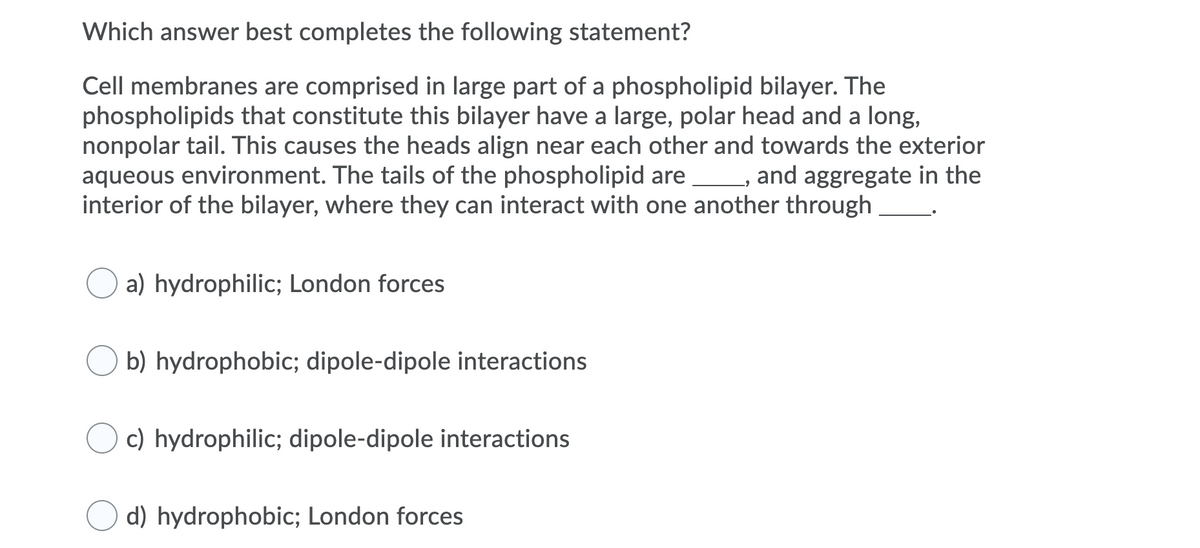Which answer best completes the following statement? Cell membranes are comprised in large part of a phospholipid bilayer. The phospholipids that constitute this bilayer have a large, polar head and a long, nonpolar tail. This causes the heads align near each other and towards the exterior aqueous environment. The tails of the phospholipid are , and aggregate in the interior of the bilayer, where they can interact with one another through O a) hydrophilic; London forces O b) hydrophobic; dipole-dipole interactions c) hydrophilic; dipole-dipole interactions d) hydrophobic; London forces
Which answer best completes the following statement? Cell membranes are comprised in large part of a phospholipid bilayer. The phospholipids that constitute this bilayer have a large, polar head and a long, nonpolar tail. This causes the heads align near each other and towards the exterior aqueous environment. The tails of the phospholipid are , and aggregate in the interior of the bilayer, where they can interact with one another through O a) hydrophilic; London forces O b) hydrophobic; dipole-dipole interactions c) hydrophilic; dipole-dipole interactions d) hydrophobic; London forces
World of Chemistry, 3rd edition
3rd Edition
ISBN:9781133109655
Author:Steven S. Zumdahl, Susan L. Zumdahl, Donald J. DeCoste
Publisher:Steven S. Zumdahl, Susan L. Zumdahl, Donald J. DeCoste
Chapter21: Biochemistry
Section: Chapter Questions
Problem 6A
Related questions
Question

Transcribed Image Text:Which answer best completes the following statement?
Cell membranes are comprised in large part of a phospholipid bilayer. The
phospholipids that constitute this bilayer have a large, polar head and a long,
nonpolar tail. This causes the heads align near each other and towards the exterior
aqueous environment. The tails of the phospholipid are , and aggregate in the
interior of the bilayer, where they can interact with one another through
a) hydrophilic; London forces
b) hydrophobic; dipole-dipole interactions
c) hydrophilic; dipole-dipole interactions
d) hydrophobic; London forces
Expert Solution
This question has been solved!
Explore an expertly crafted, step-by-step solution for a thorough understanding of key concepts.
This is a popular solution!
Trending now
This is a popular solution!
Step by step
Solved in 2 steps

Knowledge Booster
Learn more about
Need a deep-dive on the concept behind this application? Look no further. Learn more about this topic, chemistry and related others by exploring similar questions and additional content below.Recommended textbooks for you

World of Chemistry, 3rd edition
Chemistry
ISBN:
9781133109655
Author:
Steven S. Zumdahl, Susan L. Zumdahl, Donald J. DeCoste
Publisher:
Brooks / Cole / Cengage Learning

Chemistry for Today: General, Organic, and Bioche…
Chemistry
ISBN:
9781305960060
Author:
Spencer L. Seager, Michael R. Slabaugh, Maren S. Hansen
Publisher:
Cengage Learning

World of Chemistry, 3rd edition
Chemistry
ISBN:
9781133109655
Author:
Steven S. Zumdahl, Susan L. Zumdahl, Donald J. DeCoste
Publisher:
Brooks / Cole / Cengage Learning

Chemistry for Today: General, Organic, and Bioche…
Chemistry
ISBN:
9781305960060
Author:
Spencer L. Seager, Michael R. Slabaugh, Maren S. Hansen
Publisher:
Cengage Learning